Abstract
Circumcisions are performed either prophylactically in the neonatal period or therapeutically at a later age. About 10% of males not circumcised at birth will eventually require circumcision. The present neonatal circumcision rate is about 80% in the United States and 40% in Canada. The single most important determinant of whether a newborn male will be circumcised is the attitude of the attending physician. The literature was reviewed to determine the proven benefits of circumcision and to compare these with the known risks. Circumcising the newborn facilitates penile hygiene, prevents cancer of the penis and decreases the incidence of genital herpes in later life. Whether it decreases the incidence of cancer of the cervix is still uncertain. More important, neonatal circumcision is associated with much lower morbidity and mortality and with lower costs than therapeutic circumcision. Thus, prophylactic circumcision is recommended for the male population as a whole.
Full text
PDF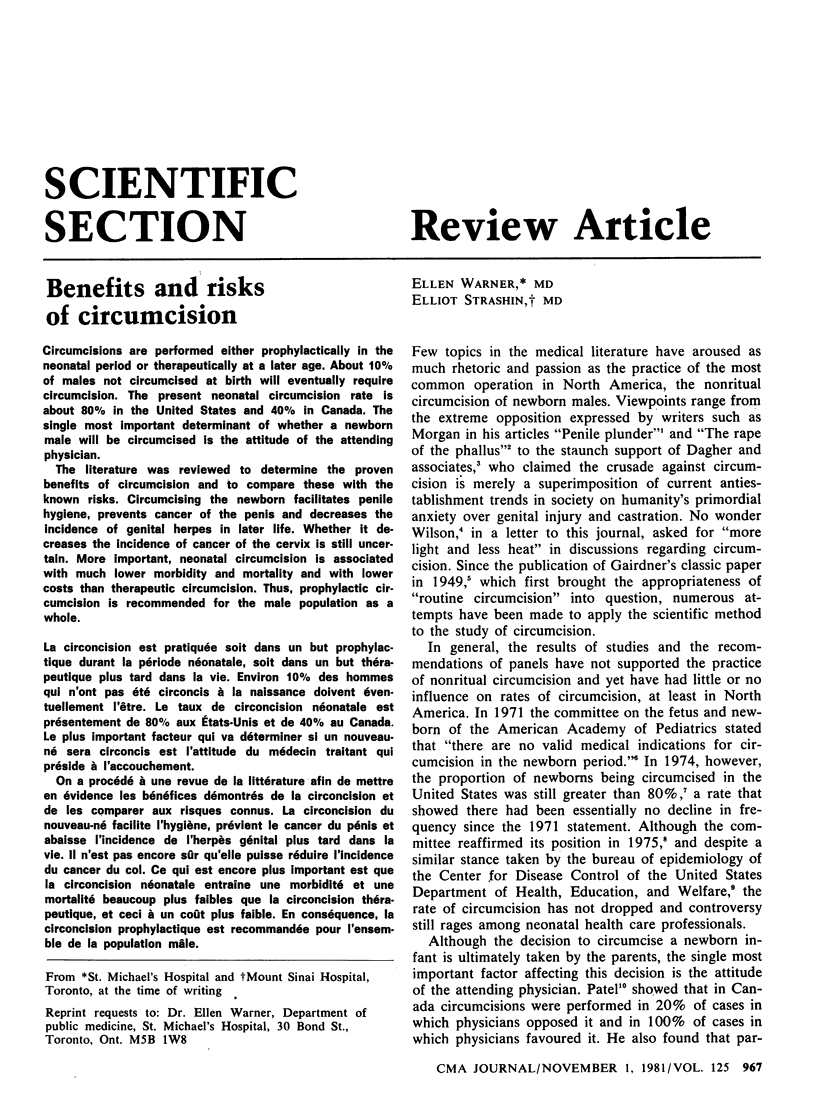
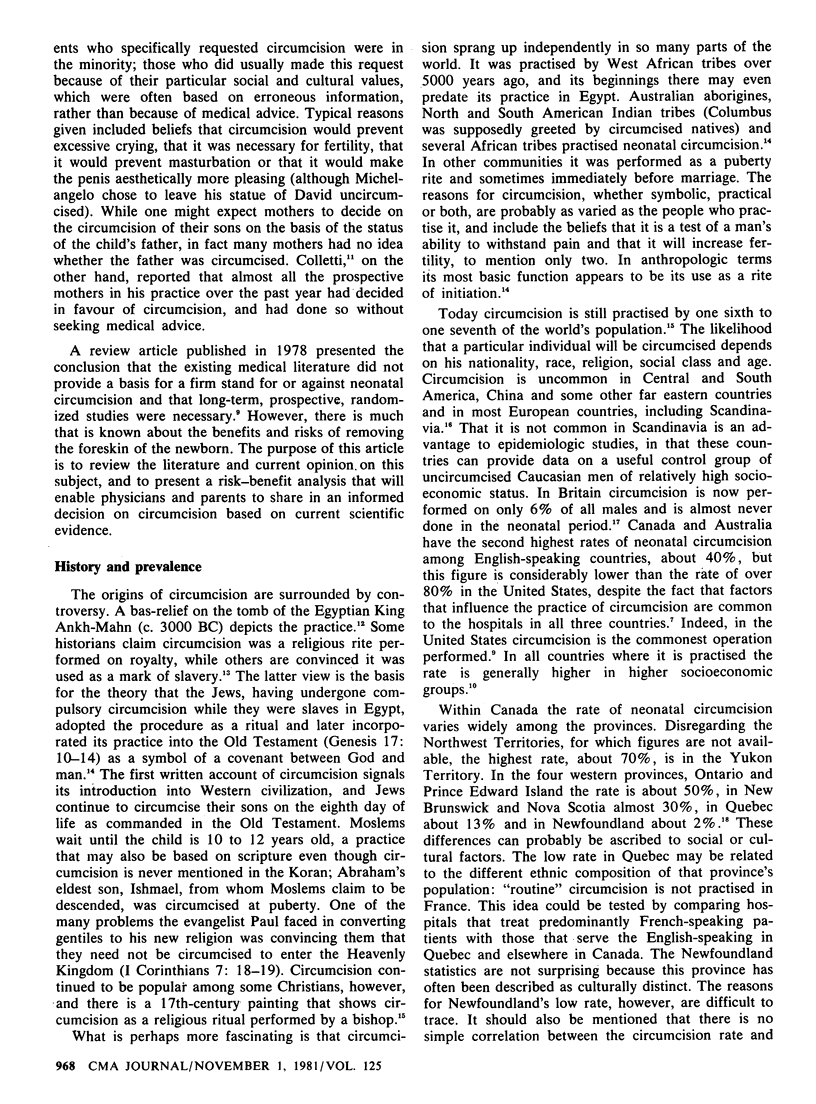
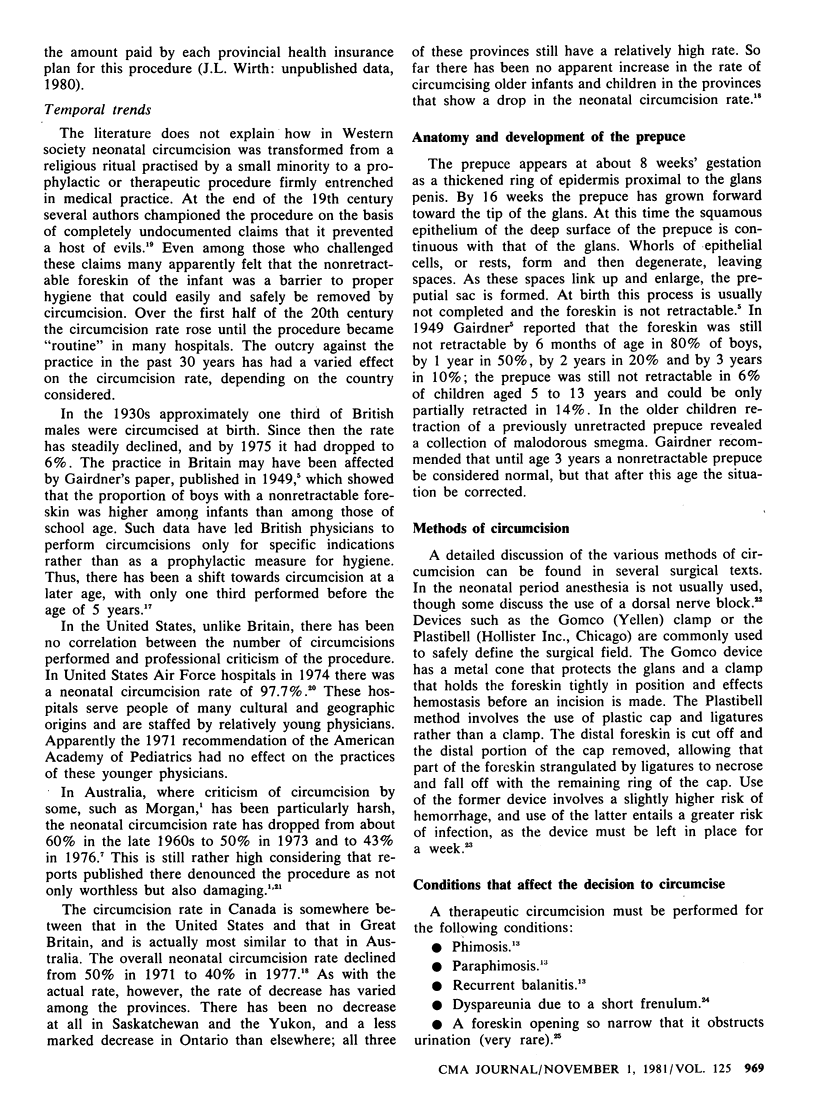
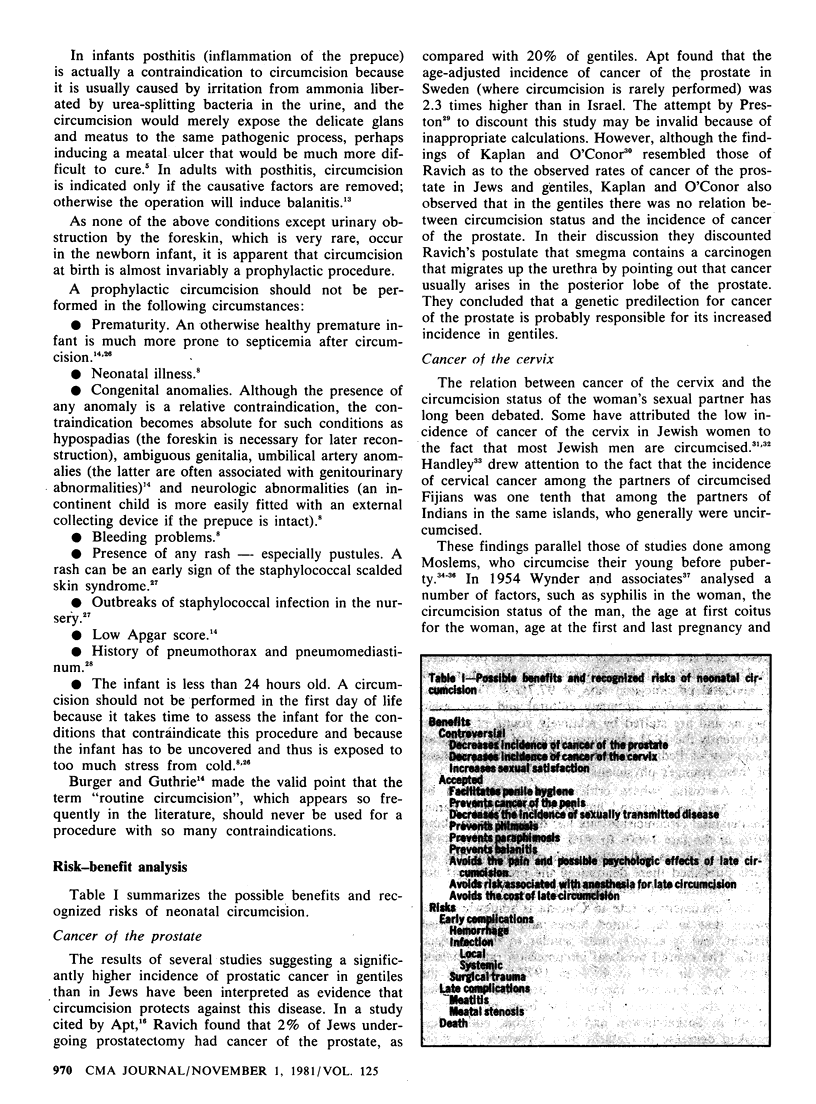
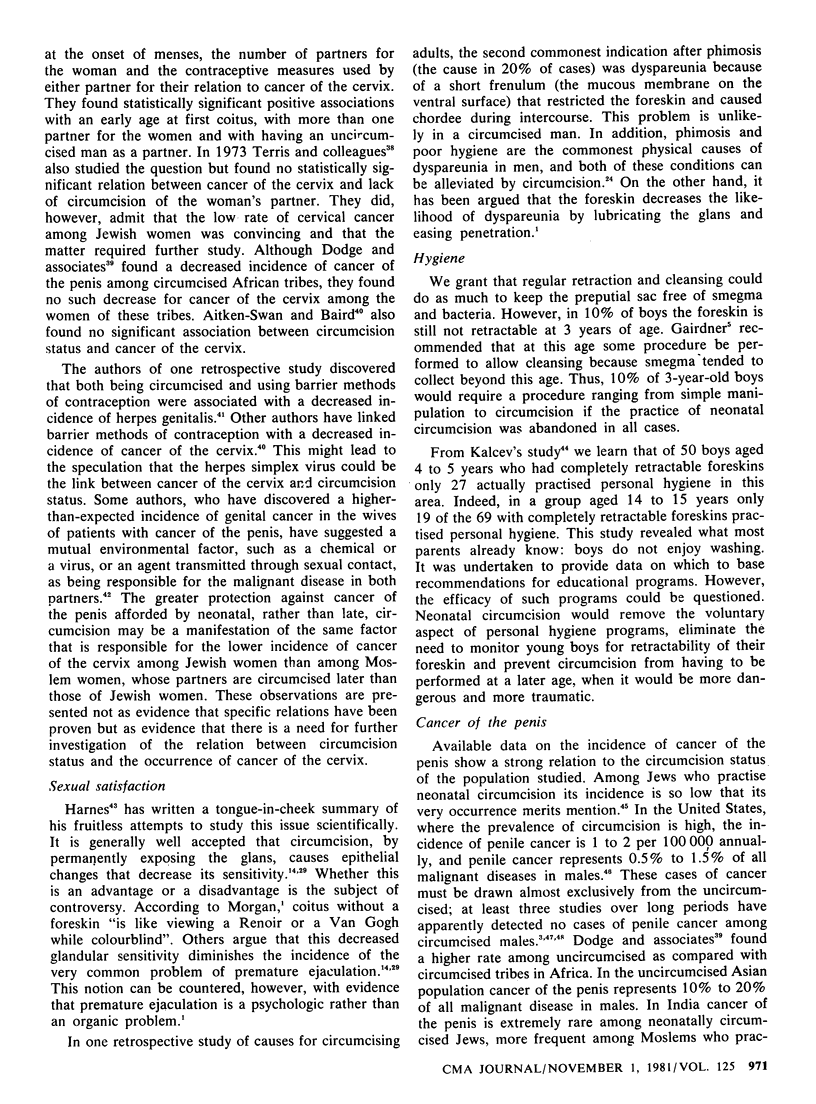
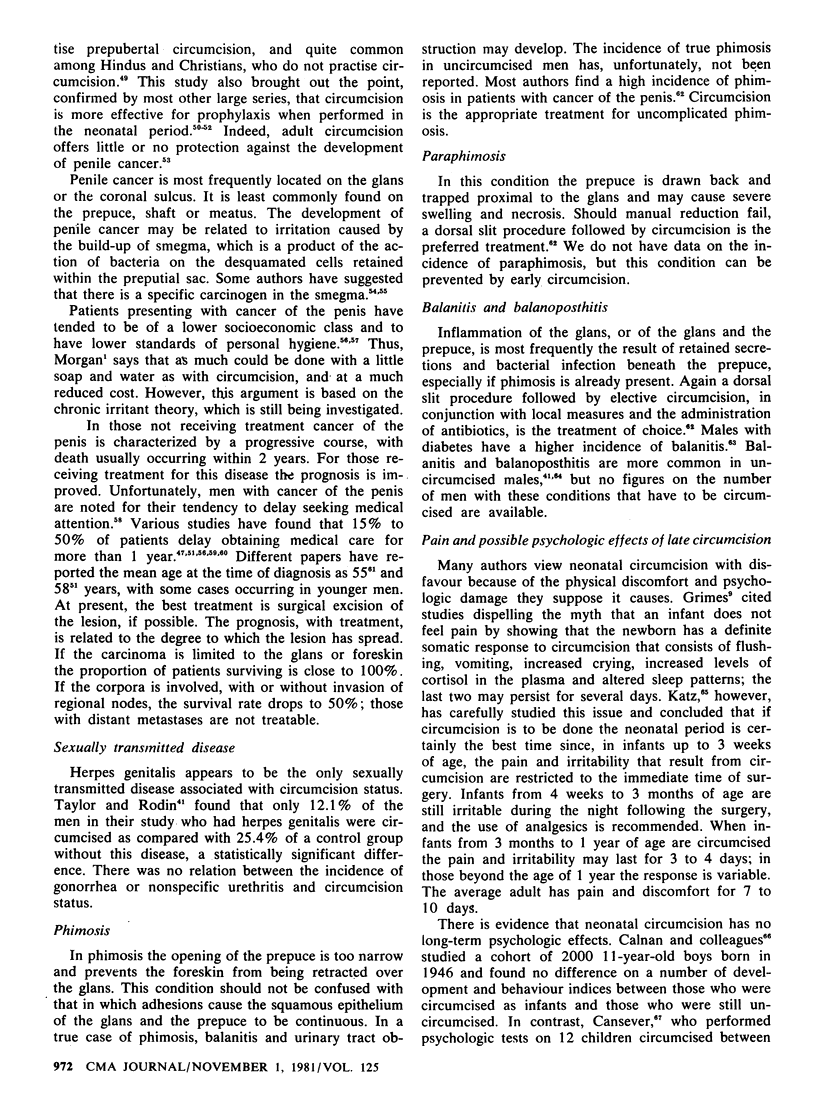
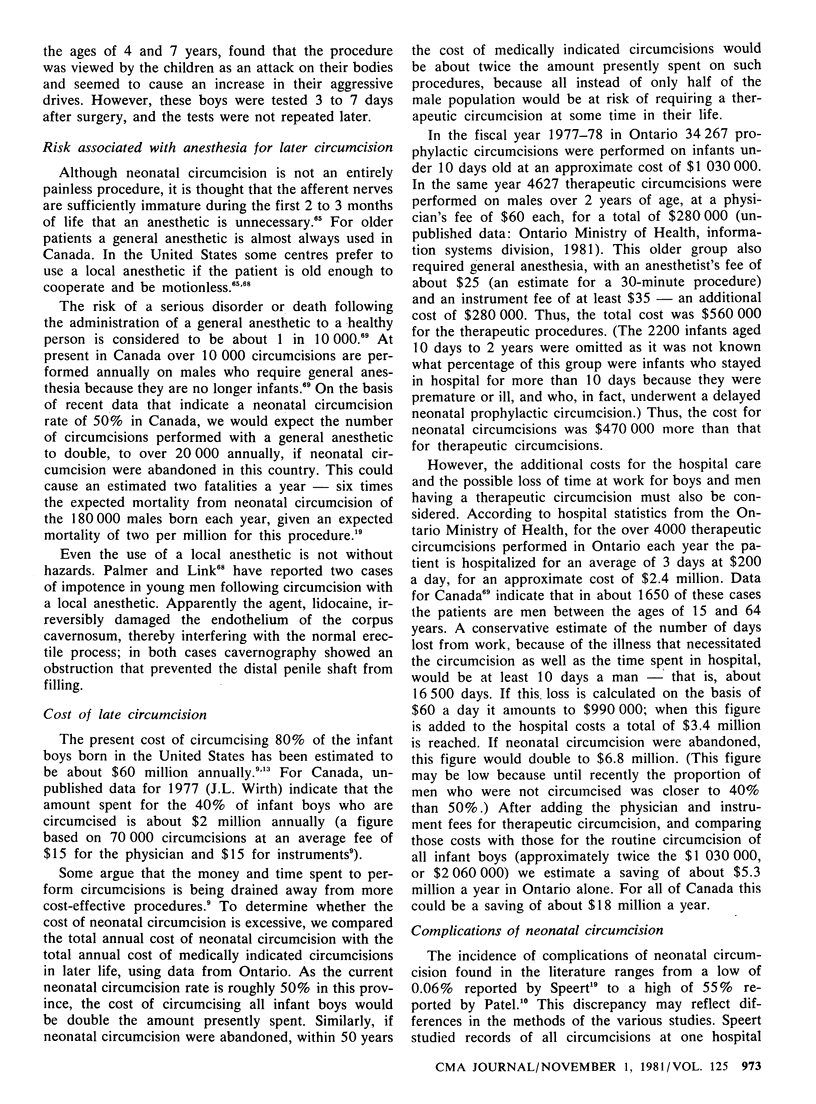
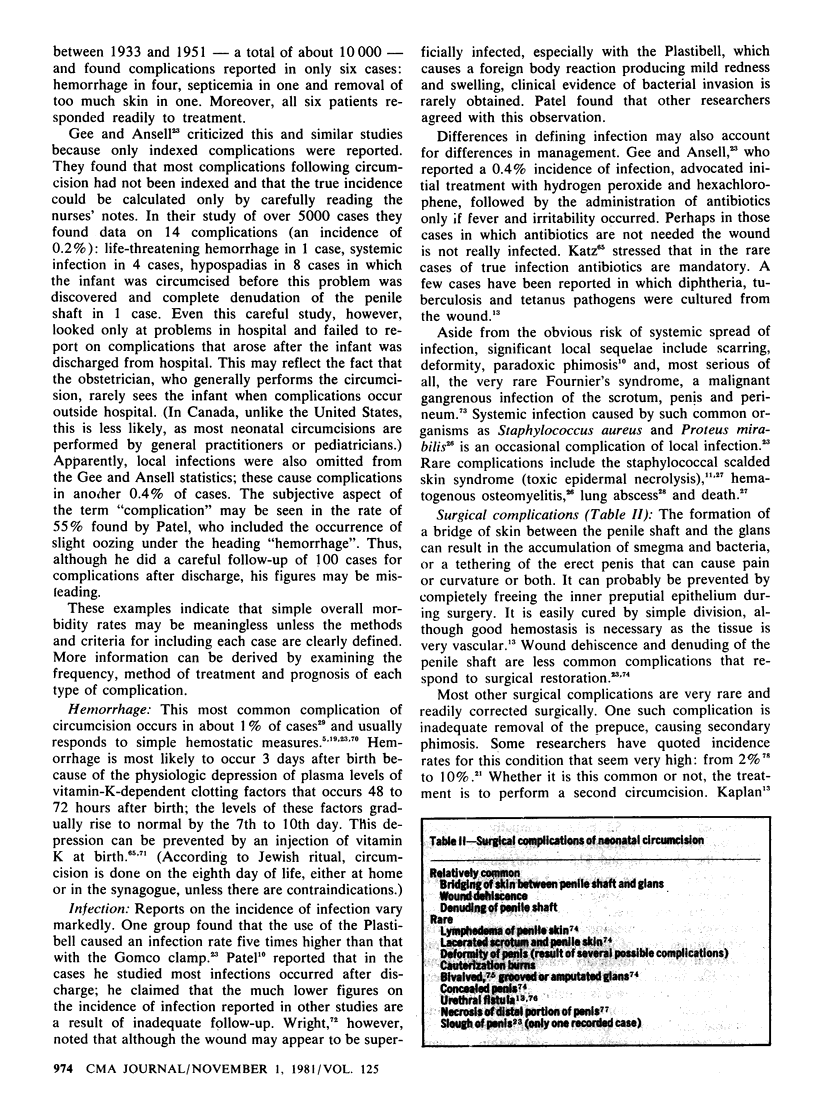
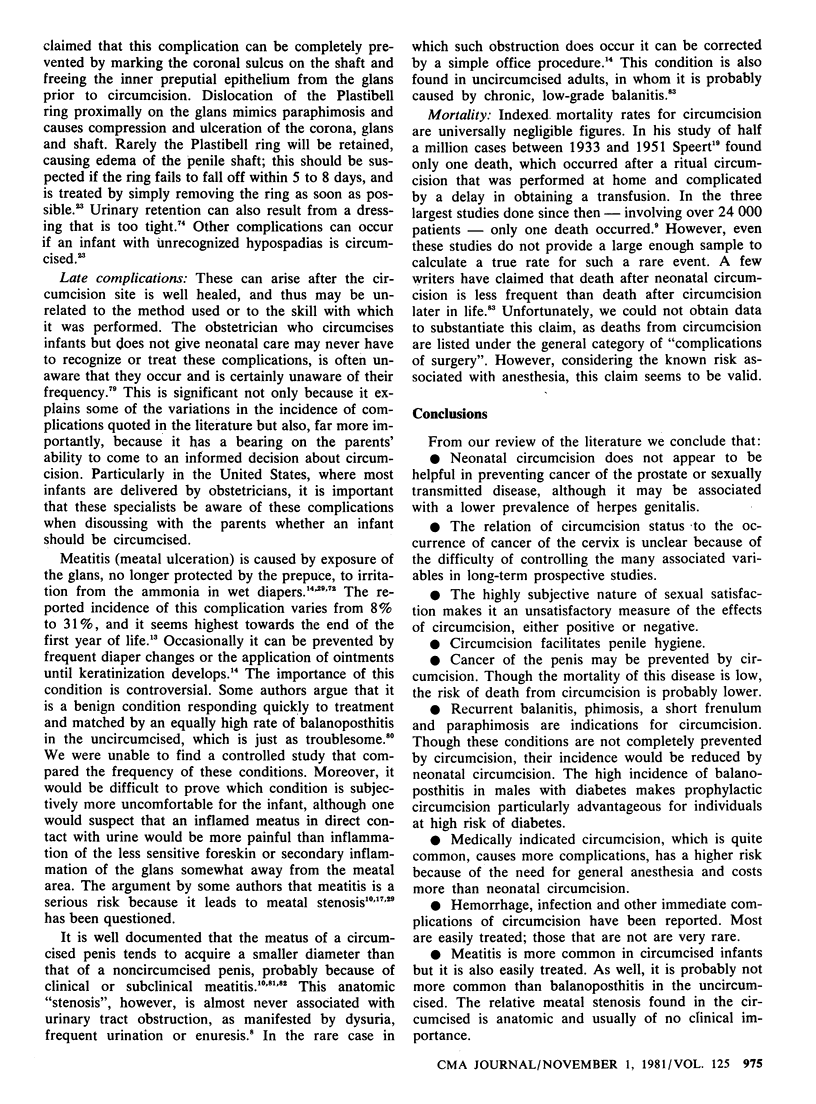
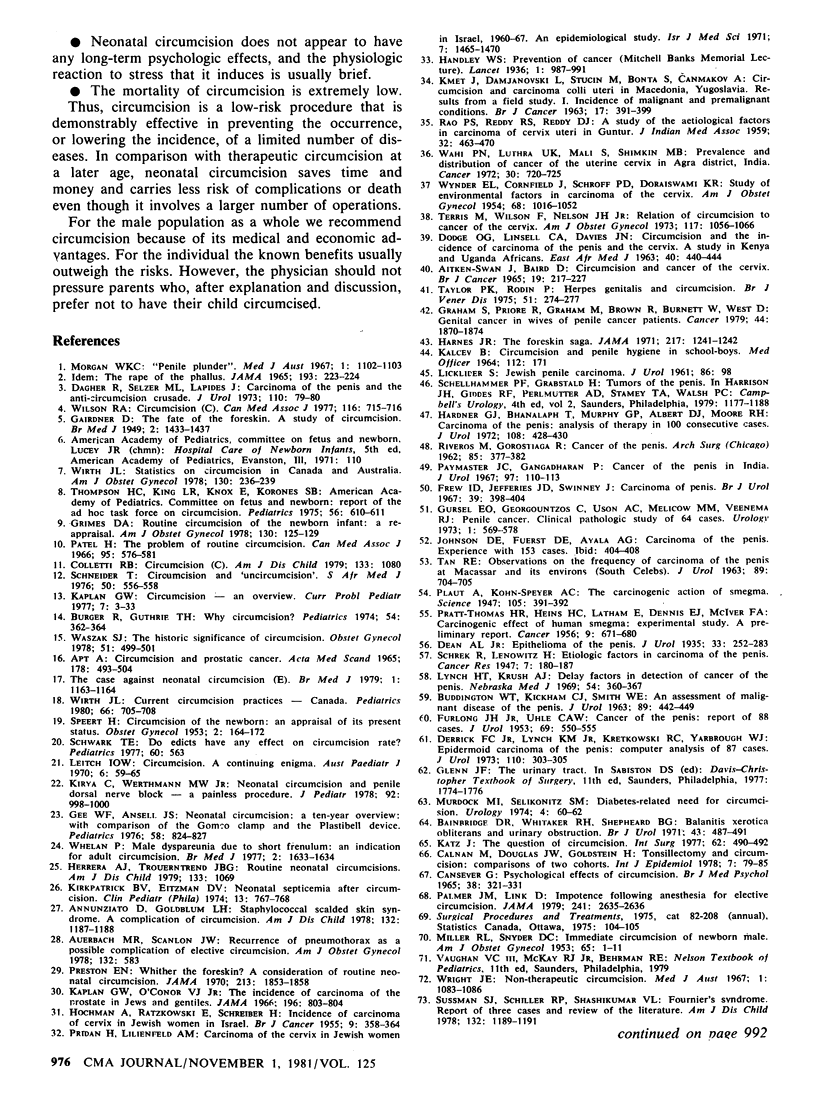
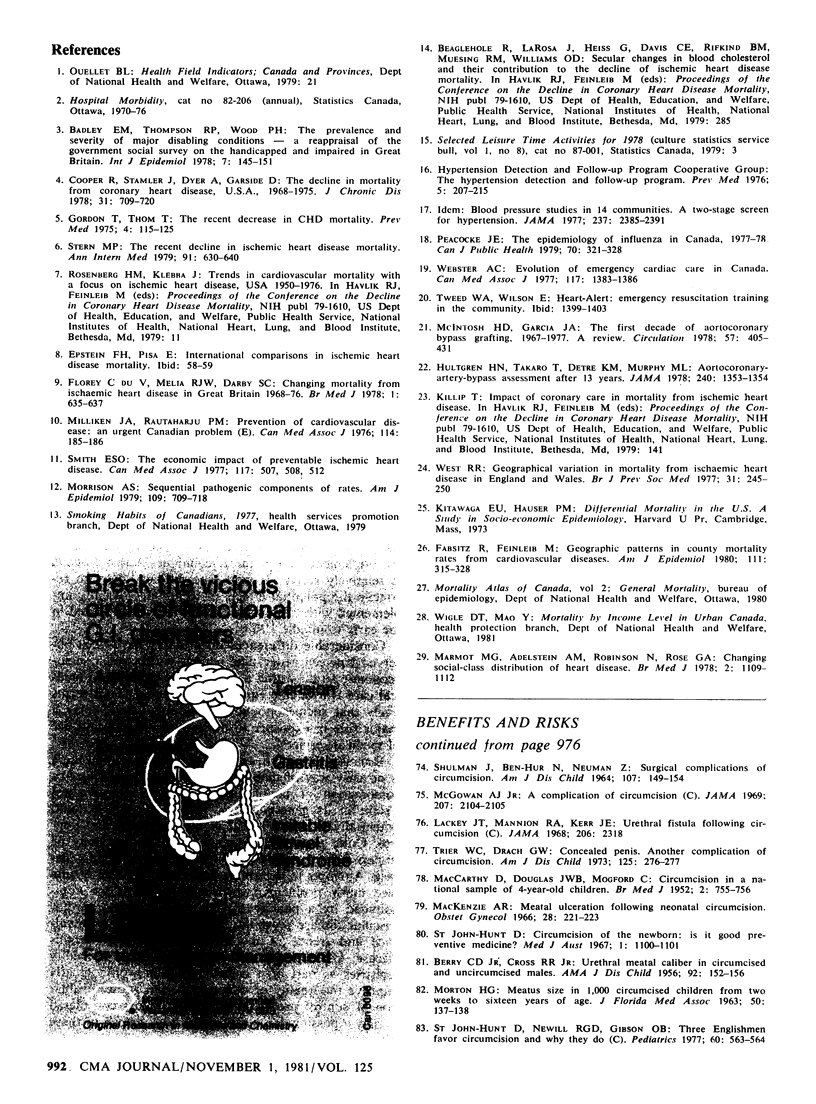
Selected References
These references are in PubMed. This may not be the complete list of references from this article.
- AITKEN-SWAN J., BAIRD D. CIRCUMCISION AND CANCER OF THE CERVIX. Br J Cancer. 1965 Jun;19:217–227. doi: 10.1038/bjc.1965.27. [DOI] [PMC free article] [PubMed] [Google Scholar]
- Annunziato D., Goldblum L. M. Staphylococcal scalded skin syndrome. A complication of circumcision. Am J Dis Child. 1978 Dec;132(12):1187–1188. doi: 10.1001/archpedi.1978.02120370035008. [DOI] [PubMed] [Google Scholar]
- Apt A. Circumcision and prostatic cancer. Acta Med Scand. 1965 Oct;178(4):493–504. doi: 10.1111/j.0954-6820.1965.tb04294.x. [DOI] [PubMed] [Google Scholar]
- Auerbach M. R., Scanlon J. W. Recurrence of pneumothorax as a possible complication of elective circumcision. Am J Obstet Gynecol. 1978 Nov 1;132(5):583–583. doi: 10.1016/0002-9378(78)90760-3. [DOI] [PubMed] [Google Scholar]
- BERRY C. D., Jr, CROSS R. R., Jr Urethral meatal caliber in circumcised and uncircumcised males. AMA J Dis Child. 1956 Aug;92(2):152–156. doi: 10.1001/archpedi.1956.02060030146007. [DOI] [PubMed] [Google Scholar]
- Bainbridge D. R., Whitaker R. H., Shepheard B. G. Balanitis xerotica obliterans and urinary obstruction. Br J Urol. 1971 Aug;43(4):487–491. doi: 10.1111/j.1464-410x.1971.tb12073.x. [DOI] [PubMed] [Google Scholar]
- Burger R., Guthrie T. H. Why circumcision? Pediatrics. 1974 Sep;54(3):362–364. [PubMed] [Google Scholar]
- Calnan M., Douglas J. W., Goldstein H. Tonsillectomy and circumcision: comparisons of two cohorts. Int J Epidemiol. 1978 Mar;7(1):79–85. doi: 10.1093/ije/7.1.79. [DOI] [PubMed] [Google Scholar]
- Cansever G. Psychological effects of circumcision. Br J Med Psychol. 1965 Dec;38(4):321–331. doi: 10.1111/j.2044-8341.1965.tb01314.x. [DOI] [PubMed] [Google Scholar]
- DENNIS E. J., HEINS H. C., LATHAM E., MCIVER F. A., PRATT-THOMAS H. R. The carcinogenic effect of human smegma: an experimental study. I. Preliminary report. Cancer. 1956 Jul-Aug;9(4):671–680. doi: 10.1002/1097-0142(195607/08)9:4<671::aid-cncr2820090408>3.0.co;2-o. [DOI] [PubMed] [Google Scholar]
- DODGE O. G., LINSELL C. A., DAVIES J. N. CIRCUMCISION AND THE INCIDENCE OF CARCINOMA OF THE PENIS AND THE CERVIX. A STUDY IN KENYA AND UGANDA AFRICANS. East Afr Med J. 1963 Sep;40:440–444. [PubMed] [Google Scholar]
- Dagher R., Selzer M. L., Lapides J. Carcinoma of the penis and the anti-circumcision crusade. J Urol. 1973 Jul;110(1):79–80. doi: 10.1016/s0022-5347(17)60121-6. [DOI] [PubMed] [Google Scholar]
- Derrick F. C., Jr, Lynch K. M., Jr, Kretkowski R. C., Yarbrough W. J. Epidermoid carcinoma of the penis: computer analysis of 87 cases. J Urol. 1973 Sep;110(3):303–305. doi: 10.1016/s0022-5347(17)60196-4. [DOI] [PubMed] [Google Scholar]
- FURLONG J. H., Jr, UHLE C. A. W. Cancer of penis: a report of eighty-eight cases. J Urol. 1953 Apr;69(4):550–555. doi: 10.1016/S0022-5347(17)68111-4. [DOI] [PubMed] [Google Scholar]
- Frew I. D., Jefferies J. D., Swinney J. Carcinoma of penis. Br J Urol. 1967 Aug;39(4):398–404. doi: 10.1111/j.1464-410x.1967.tb09819.x. [DOI] [PubMed] [Google Scholar]
- GAIRDNER D. The fate of the foreskin, a study of circumcision. Br Med J. 1949 Dec 24;2(4642):1433-7, illust. doi: 10.1136/bmj.2.4642.1433. [DOI] [PMC free article] [PubMed] [Google Scholar]
- Gee W. F., Ansell J. S. Neonatal circumcision: a ten-year overview: with comparison of the Gomco clamp and the Plastibell device. Pediatrics. 1976 Dec;58(6):824–827. [PubMed] [Google Scholar]
- Graham S., Priore R., Graham M., Browne R., Burnett W., West D. Genital cancer in wives of penile cancer patients. Cancer. 1979 Nov;44(5):1870–1874. doi: 10.1002/1097-0142(197911)44:5<1870::aid-cncr2820440546>3.0.co;2-e. [DOI] [PubMed] [Google Scholar]
- Grimes D. A. Routine circumcision of the newborn infant: a reappraisal. Am J Obstet Gynecol. 1978 Jan 15;130(2):125–129. doi: 10.1016/0002-9378(78)90353-8. [DOI] [PubMed] [Google Scholar]
- Gursel E. O., Georgountzos C., Uson A. C., Melicow M. M., Veenema R. J. Penile cancer. Urology. 1973 Jun;1(6):569–578. doi: 10.1016/0090-4295(73)90517-7. [DOI] [PubMed] [Google Scholar]
- HOCHMAN A., RATZKOWSKI E., SCHREIBER H. Incidence of carcinoma of the cervix in Jewish women in Israel. Br J Cancer. 1955 Sep;9(3):358–364. doi: 10.1038/bjc.1955.34. [DOI] [PMC free article] [PubMed] [Google Scholar]
- Hardner G. J., Bhanalaph T., Murphy G. P., Albert D. J., Moore R. H. Carcinoma of the penis: analysis of therapy in 100 consecutive cases. J Urol. 1972 Sep;108(3):428–430. doi: 10.1016/s0022-5347(17)60762-6. [DOI] [PubMed] [Google Scholar]
- Harnes J. R. The foreskin saga. JAMA. 1971 Aug 30;217(9):1241–1242. [PubMed] [Google Scholar]
- Herrera A. J., Trouern-Trend J. B. Routine neonatal circumcisions. Am J Dis Child. 1979 Oct;133(10):1069–1070. doi: 10.1001/archpedi.1979.02130100093020. [DOI] [PubMed] [Google Scholar]
- KMET J., DAMJANOVSKI L., STUCIN M., BONTA S., CAKMAKOV A. CIRCUMCISION AND CARCINOMA COLLI UTERI IN MACEDONIA, YUGOSLAVIA. RESULTS FROM A FIELD STUDY. I. INCIDENCE OF MALIGNANT AND PREMALIGNANT CONDITIONS. Br J Cancer. 1963 Sep;17:391–399. doi: 10.1038/bjc.1963.54. [DOI] [PMC free article] [PubMed] [Google Scholar]
- Kaplan G. W. Circumcision--an overview. Curr Probl Pediatr. 1977 Mar;7(5):1–33. [PubMed] [Google Scholar]
- Katz J. The question of circumcision. Int Surg. 1977 Sep;62(9):490–492. [PubMed] [Google Scholar]
- Kirkpatrick B. V., Eitzman D. V. Neonatal septicemia after circumcision. Clin Pediatr (Phila) 1974 Sep;13(9):767–768. doi: 10.1177/000992287401300914. [DOI] [PubMed] [Google Scholar]
- Kirya C., Werthmann M. W., Jr Neonatal circumcision and penile dorsal nerve block--a painless procedure. J Pediatr. 1978 Jun;92(6):998–1000. doi: 10.1016/s0022-3476(78)80386-2. [DOI] [PubMed] [Google Scholar]
- Lackey J. T., Mannion R. A., Kerr J. E. Urethral fistula following circumcision. JAMA. 1968 Dec 2;206(10):2318–2318. doi: 10.1001/jama.206.10.2318b. [DOI] [PubMed] [Google Scholar]
- Leitch I. O. Circumcision. A continuing enigma. Aust Paediatr J. 1970 Jun;6(2):59–65. [PubMed] [Google Scholar]
- Lynch H. T., Krush A. J. Delay factors in detection of cancer of the penis. Nebr State Med J. 1969 Jun;54(6):360–367. [PubMed] [Google Scholar]
- MACCARTHY D., DOUGLAS J. W. B., MOGFORD C. Circumcision in a national sample of 4-year-old children. Br Med J. 1952 Oct 4;2(4787):755–756. doi: 10.1136/bmj.2.4787.755. [DOI] [PMC free article] [PubMed] [Google Scholar]
- MILLER R. L., SNYDER D. C. Immediate circumcision of the newborn male. Am J Obstet Gynecol. 1953 Jan;65(1):1–11. doi: 10.1016/0002-9378(53)90002-7. [DOI] [PubMed] [Google Scholar]
- MacKenzie A. R. Meatal ulceration following neonatal circumcision. Obstet Gynecol. 1966 Aug;28(2):221–223. doi: 10.1097/00003081-196608000-00015. [DOI] [PubMed] [Google Scholar]
- McGowan A. J., Jr A complication of circumcision. JAMA. 1969 Mar 17;207(11):2104–2105. doi: 10.1001/jama.1969.03150240124028. [DOI] [PubMed] [Google Scholar]
- Morgan W. K. "Penile plunder". Med J Aust. 1967 May 27;1(21):1102–1103. doi: 10.5694/j.1326-5377.1967.tb20892.x. [DOI] [PubMed] [Google Scholar]
- Palmer J. M., Link D. Impotence following anesthesia for elective circumcision. JAMA. 1979 Jun 15;241(24):2635–2636. [PubMed] [Google Scholar]
- Patel H. The problem of routine circumcision. Can Med Assoc J. 1966 Sep 10;95(11):576–581. [PMC free article] [PubMed] [Google Scholar]
- Paymaster J. C., Gangadharan P. Cancer of the penis in India. J Urol. 1967 Jan;97(1):110–113. doi: 10.1016/S0022-5347(17)62992-6. [DOI] [PubMed] [Google Scholar]
- Plaut A., Kohn-Speyer A. C. The Carcinogenic Action of Smegma. Science. 1947 Apr 11;105(2728):391–392. doi: 10.1126/science.105.2728.391-a. [DOI] [PubMed] [Google Scholar]
- Preston E. N. Whither the foreskin? A consideration of routine neonatal circumcision. JAMA. 1970 Sep 14;213(11):1853–1858. doi: 10.1001/jama.213.11.1853. [DOI] [PubMed] [Google Scholar]
- Pridan H., Lilienfeld A. M. Carcinoma of the cervix in Jewish women in Israel, 1960-67. An epidemiological study. Isr J Med Sci. 1971 Dec;7(12):1465–1470. [PubMed] [Google Scholar]
- RAO P. S., REDDY R. S., REDDY D. J. A study of the aetiological factors in carcinoma of cervix uteri in Guntur. J Indian Med Assoc. 1959 Jun 16;32(12):463–470. [PubMed] [Google Scholar]
- RIVEROS M., GOROSTIAGA R. Cancer of the penis. Arch Surg. 1962 Sep;85:377–382. doi: 10.1001/archsurg.1962.01310030025004. [DOI] [PubMed] [Google Scholar]
- SHULMAN J., BEN-HUR N., NEUMAN Z. SURGICAL COMPLICATIONS OF CIRCUMCISION. Am J Dis Child. 1964 Feb;107:149–154. doi: 10.1001/archpedi.1964.02080060151007. [DOI] [PubMed] [Google Scholar]
- SPEERT H. Circumcision of the newborn; an appraisal of its present status. Obstet Gynecol. 1953 Aug;2(2):164–172. [PubMed] [Google Scholar]
- Schneider T. Circumcision and 'uncircumcision'. S Afr Med J. 1976 Mar 27;50(14):556–558. [PubMed] [Google Scholar]
- St John-Hunt D. Circumcision of the newborn: is it good preventive medicine? Med J Aust. 1967 May 27;1(21):1100–1101. doi: 10.5694/j.1326-5377.1967.tb20891.x. [DOI] [PubMed] [Google Scholar]
- St John-Hunt D., Newill R. G., Gibson O. B. Three Englishmen favor circumcision and why they do. Pediatrics. 1977 Oct;60(4):563–564. [PubMed] [Google Scholar]
- St John-Hunt D., Newill R. G., Gibson O. B. Three Englishmen favor circumcision and why they do. Pediatrics. 1977 Oct;60(4):563–564. [PubMed] [Google Scholar]
- Sussman S. J., Schiller R. P., Shashikumar V. L. Fournier's syndrome. Report of three cases and review of the literature. Am J Dis Child. 1978 Dec;132(12):1189–1191. doi: 10.1001/archpedi.1978.02120370037009. [DOI] [PubMed] [Google Scholar]
- TAN R. E. Observations on frequency of carcinoma of the penis at Macassar and its environs (South Celebes). J Urol. 1963 May;89:704–705. doi: 10.1016/S0022-5347(17)64629-9. [DOI] [PubMed] [Google Scholar]
- Taylor P. K., Rodin P. Herpes genitalis and circumcision. Br J Vener Dis. 1975 Aug;51(4):274–277. doi: 10.1136/sti.51.4.274. [DOI] [PMC free article] [PubMed] [Google Scholar]
- Terris M., Wilson F., Nelson J. H., Jr Relation of circumcision to cancer of the cervix. Am J Obstet Gynecol. 1973 Dec 15;117(8):1056–1066. doi: 10.1016/0002-9378(73)90754-0. [DOI] [PubMed] [Google Scholar]
- Thompson H. C., King L. R., Knox E., Korones S. B. Report of the ad hoc task force on circumcision. Pediatrics. 1975 Oct;56(4):610–611. [PubMed] [Google Scholar]
- Trier W. C., Drach G. W. Concealed penis. Another complication of circumcision. Am J Dis Child. 1973 Feb;125(2):276–277. doi: 10.1001/archpedi.1973.04160020088018. [DOI] [PubMed] [Google Scholar]
- WYNDER E. L., CORNFIELD J., SCHROFF P. D., DORAISWAMI K. R. A study of environmental factors in carcinoma of the cervix. Am J Obstet Gynecol. 1954 Oct;68(4):1016-47; discussion, 1048-52. doi: 10.1016/s0002-9378(16)38400-9. [DOI] [PubMed] [Google Scholar]
- Wahi P. N., Luthra U. K., Mali S., Shimkin M. B. Prevalence and distribution of cancer of the uterine cervix in Agra district, India. Cancer. 1972 Sep;30(3):720–725. doi: 10.1002/1097-0142(197209)30:3<720::aid-cncr2820300320>3.0.co;2-d. [DOI] [PubMed] [Google Scholar]
- Waszak S. J. The historic significance of circumcision. Obstet Gynecol. 1978 Apr;51(4):499–501. doi: 10.1097/00006250-197804000-00023. [DOI] [PubMed] [Google Scholar]
- Whelan P. Male dyspareunia due to short frenulum: an indication for adult circumcision. Br Med J. 1977 Dec 24;2(6103):1633–1634. doi: 10.1136/bmj.2.6103.1633-a. [DOI] [PMC free article] [PubMed] [Google Scholar]
- Wilson R. A. Circumcism. Can Med Assoc J. 1977 Apr 9;116(7):715–716. [PMC free article] [PubMed] [Google Scholar]
- Wirth J. L. Current circumcision practices: Canada. Pediatrics. 1980 Nov;66(5):705–708. [PubMed] [Google Scholar]
- Wirth J. L. Statistics on circumcision in Canada and Australia. Am J Obstet Gynecol. 1978 Jan 15;130(2):236–239. doi: 10.1016/0002-9378(78)90379-4. [DOI] [PubMed] [Google Scholar]
- Wright J. E. Non-therapeutic circumcision. Med J Aust. 1967 May 27;1(21):1083–1086. doi: 10.5694/j.1326-5377.1967.tb20877.x. [DOI] [PubMed] [Google Scholar]


